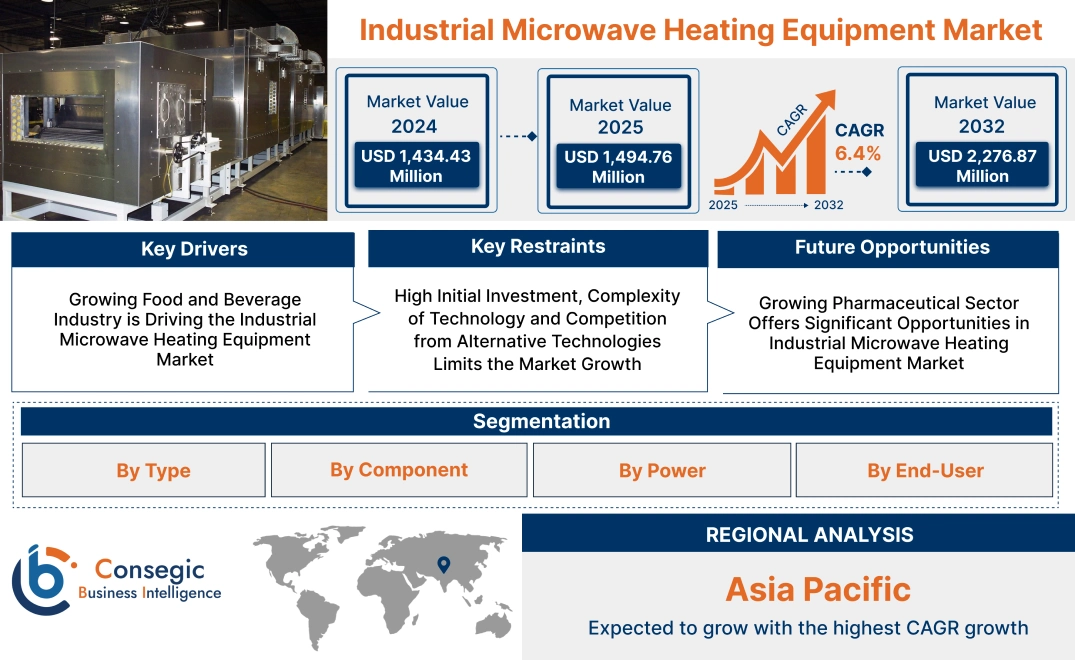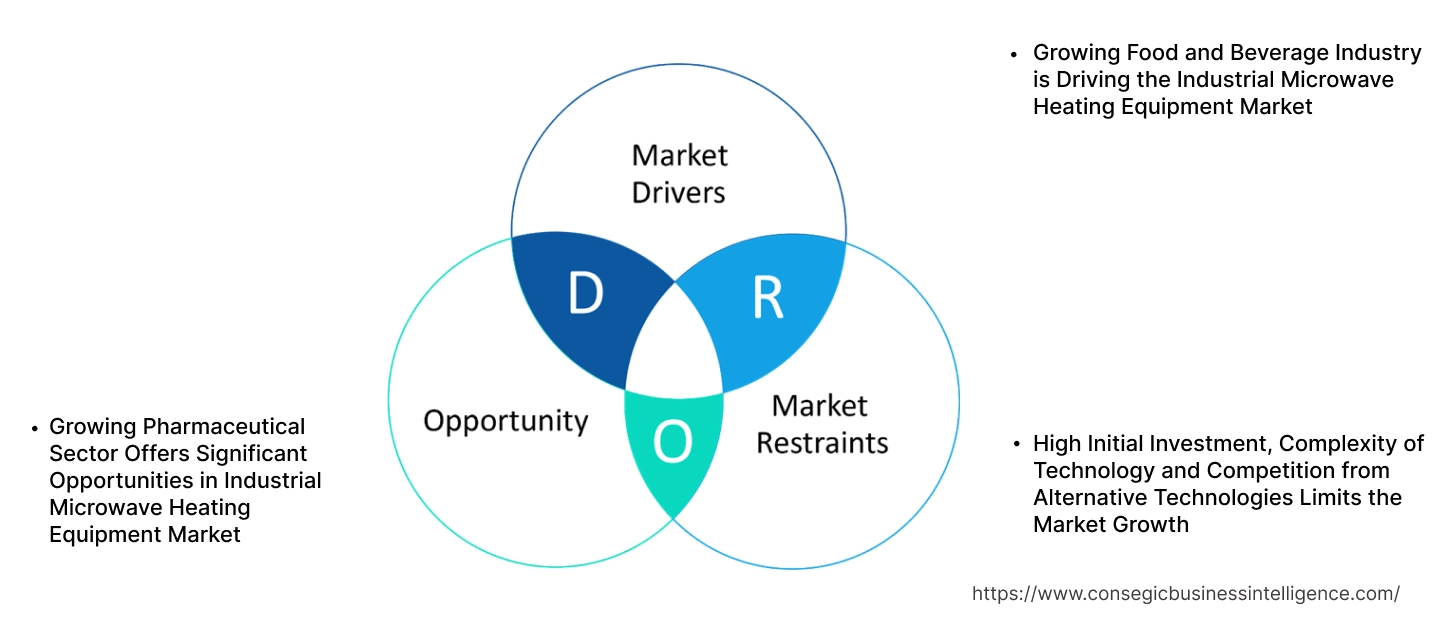- Summary
- Table Of Content
- Methodology
Industrial Microwave Heating Equipment Market Size:
Industrial Microwave Heating Equipment Market is estimated to reach over USD 2,276.87 Million by 2032 from a value of USD 1,434.43 Million in 2024 and is projected to grow by USD 1,494.76 Million in 2025, growing at a CAGR of 6.4% from 2025 to 2032
Industrial Microwave Heating Equipment Market Scope & Overview:
Industrial microwave heating equipment employs electromagnetic waves in the microwave frequency range to generate heat within materials. This technology offers numerous advantages over conventional heating methods, including faster and more uniform heating, increased energy efficiency, and improved product quality. As a result, it has found widespread applications in various industries. Further, key benefits of industrial microwave heating equipment include its ability to significantly reduce processing time compared to conventional methods, leading to increased production throughput. Microwaves penetrate materials evenly, ensuring uniform temperature distribution and eliminating hot or cold spots. This results in improved product quality, consistency, and shelf life which in turn drives the industrial microwave heating equipment market. Industrial microwave heating is being increasingly applied in food processing for tempering, cooking, drying, pasteurization, and sterilization. In material processing, it is used for drying, curing, and bonding materials like wood, ceramics, and textiles. Furthermore, industrial microwave heating equipment market is experiencing significant growth due to its advantages and expanding applications. Continuous research and development are leading to improvements in technology, including higher power levels and enhanced control systems.
Key Drivers:
Growing Food and Beverage Industry is Driving the Industrial Microwave Heating Equipment Market
The booming food and beverage sector is a major catalyst for the industrial microwave heating equipment market. As consumer demand for processed and convenience foods rises, manufacturers are seeking efficient and reliable heating solutions. Microwave technology offers significant advantages in this sector, including faster and more uniform heating, leading to increased production throughput and improved product quality. This translates to quicker cooking, drying, and pasteurization processes, essential for meeting high production demands.
- For instance, according to Food & Drink Europe, the 2022 EU food and drink industry data reveals Europe food and beverage sector is a major player, employing over 4.6 million and generating revenue worth 1.1 trillion Euros. The robust EU food and drink sector, with its massive workforce and substantial revenue, significantly impacts the industrial microwave heating equipment market by enhancing efficiency and improving quality & safety.
The trend of growth is expected to continue as the food and beverage sector expands globally, creating more opportunities for industrial microwave heating equipment market.
Key Restraints:
High Initial Investment, Complexity of Technology and Competition from Alternative Technologies Limits the Market Growth
There are several factors that hinder the industrial microwave heating equipment market. A significant barrier is the high initial investment required for purchasing and installing these systems. This can be a deterrent, particularly for smaller businesses, despite the long-term cost savings and efficiency gains. The complexity of technology also presents a challenge. Operating and maintaining microwave heating systems requires specialized expertise, often necessitating investment in training or hiring skilled personnel. This adds to the overall cost and complexity of implementation. Furthermore, the market faces stiff competition from alternative heating technologies like infrared, radio frequency, and induction heating. These competing technologies may be more suitable for specific applications or offer a more cost-effective solution, thus limiting the broader adoption of microwave heating. These combined factors of high upfront costs, technological complexities, and competition from other methods create significant hurdles to wider market expansion.
Future Opportunities :
Growing Pharmaceutical Sector Offers Significant Opportunities in Industrial Microwave Heating Equipment Market
The expansion of pharmaceutical sector fuels significant opportunities for the industrial microwave heating equipment market. Pharmaceutical processes often require precise temperature control and uniform heating, crucial for drug synthesis, formulation, and sterilization. Microwave heating meets these critical requirements, ensuring consistent and efficient heating, leading to improved product quality and faster processing times. Furthermore, microwave technology accelerates drug discovery by enabling rapid chemical reactions and synthesis, shortening R&D timelines. Sterilization and disinfection of equipment and materials are also effectively achieved with microwave heating, ensuring product safety and regulatory compliance.
- For instance, according to the European Federation of Pharmaceutical Industries and Associations, the total production of pharmaceutical industry in Europe was valued at USD 375.24 billion in 2022, witnessing a growth of nearly 5% in comparison to USD 357.52 billion in 2021. The presence of a large pharmaceutical sector in the region drives the market.
Thus, expansion of pharmaceutical sector, driven by factors like an aging population and increased healthcare spending, the demand for advanced processing technologies like microwave heating will rise, creating a robust market for specialized equipment.
Industrial Microwave Heating Equipment Market Segmental Analysis :
By Type:
Based on the type, the market is segmented into batch and continuous.
Trends in the Type:
- Increasing focus on reduced energy consumption, lower emissions, and the use of eco-friendly materials is driving the market growth.
- Manufacturers are offering more customizable batch systems to cater to specific needs and smaller production volumes. This includes variations in chamber size, power output, and control features.
Continuous accounted for the largest revenue share in the year 2024 and in expected to witness highest CAGR during forecast period
- A major trend is the integration of continuous microwave heating systems with automated production lines. This allows for seamless processing, increased throughput, and reduced labor costs.
- Further, continuous systems are being designed to handle even higher volumes of material, catering to the needs of large-scale industries like food processing and material manufacturing.
- Furthermore, real-time monitoring and control systems are becoming more prevalent in continuous systems.
- Thus, based on analysis, real-time monitoring and control systems and capacity to handle higher volumes of material is driving the market.
By Component:
Based on the component, the market is segmented into microwave generation source, waveguides, control systems, and others
Trends in the Component:
- Increasing trend towards more compact and modular designs for all components, making it easier to integrate microwave heating systems into existing production lines.
- Flexible waveguides are being developed to allow for greater flexibility in system design and easier integration with different processing equipment.
Microwave generation source accounted for the largest revenue share in the year 2024.
- While magnetrons are still dominant, solid-state microwave generators are gaining traction. They offer advantages like longer lifespan, more precise power control, and the ability to operate at different frequencies
- Further, research is focused on improving the energy efficiency of both magnetrons and solid-state generators, reducing operating costs and environmental impact.
- Thus, as per analysis, technological advancement in microwave generation sources focused on improving energy efficiency is driving the industrial microwave heating equipment market.
Control Systems is anticipated to register the fastest CAGR during the forecast period.
- Integration of advanced sensors for real-time monitoring of temperature, moisture content, and other critical parameters. This enables more precise process control and improved product consistency.
- Further, the use of artificial intelligence and machine learning algorithms to optimize heating processes, predict maintenance needs, and improve overall system efficiency.
- Furthermore, increased connectivity and integration with the Internet of Things (IoT) for remote monitoring, data analysis, and predictive maintenance. This allows for better control and optimization of microwave heating systems.
- Therefore, integration of advanced sensors and use of artificial intelligence and machine learning algorithms is anticipated to boost the growth of the market during the forecast period.
By Power:
Based on power, the market is segmented into up to 25 kW, 25 kW - 100 kW, and above 100 kW
Trends in Power:
- Continuous technological advancements in microwave generation technology, improved waveguide design, and efficient cooling systems.
- Increasing use of sensors and data analytics to predict potential equipment failures and schedule maintenance proactively.
25 kW - 100 kW accounted for the largest revenue share of 59.21% in the year 2024.
- A major trend in this mid-range power segment is seamless integration with automated production lines. This includes features like robotic loading and unloading, automated material handling, and communication protocols for integration with PLCs and other control systems.
- Further, manufacturers are constantly working to improve energy efficiency and throughput of these systems. This includes optimizing microwave applicator design, improving insulation, and implementing energy recovery systems.
- Thus, according to analysis seamless integration with automated production lines and increasing focus on improving energy efficiency is driving the market.
Up to 25 kW is anticipated to register the fastest CAGR during the forecast period.
- Manufacturers are focusing on intuitive user interfaces, often with touchscreen controls and pre-programmed recipes, to make these units accessible to a wider range of users.
- Furthermore, focus on more compact designs that can be easily integrated into lab spaces or smaller production environments. Some units are even designed to be portable, allowing for on-site testing or flexible deployment.
- Therefore, digitalization and trends towards more compact designs is anticipated to boost the growth of the market during the forecast period.
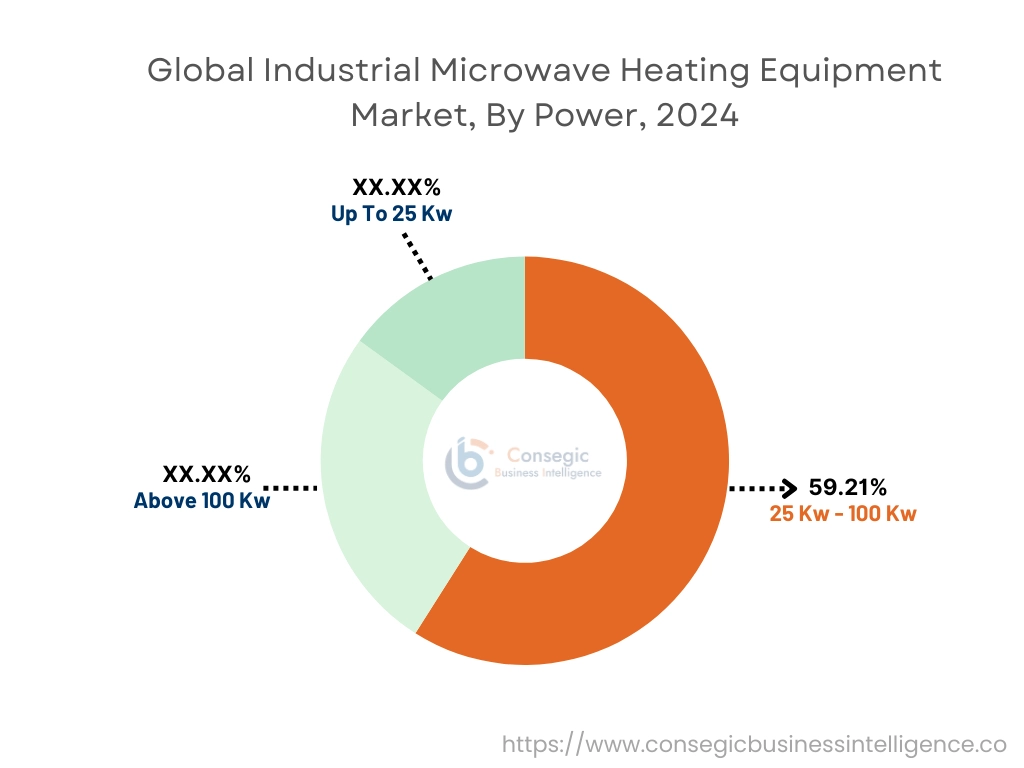
By End-User:
Based on the end user, the market is segmented into pharmaceutical, food & beverage, plastics & rubber, chemicals, paper, and others
Trends in the End User:
- In chemical sector industrial heating equipment is used for various chemical processes, including synthesis, catalysis, and extraction.
- Microwave technology is being adapted for specialized applications in the paper industry, such as drying coated paper, processing recycled paper, and improving the strength and quality of paper products.
Food & Beverage accounted for the largest revenue share in the year 2024.
- Growing size of the food and beverage sector in emerging economies is driving the market growth of industrial microwave heating equipment market.
- Further, growing adoption of heating systems for different food products to optimize cooking, drying, pasteurization, and sterilization processes while preserving nutritional value and sensory attributes.
- For instance, Hitachi 2M121A is fixed frequency continuous wave magnetron intended for use in microwave ovens and industrial microwave heating applications. The useful RF power output at 2455 MHz band is approx. 1.4 kW into a matched load.
- Thus, based on analysis, growing size of food and beverage sector and adoption of heating systems for different food products is driving the industrial microwave heating equipment market.
Pharmaceutical is anticipated to register the fastest CAGR during the forecast period.
- Pharmaceutical processes require extremely precise temperature control and uniform heating which in turn drives industrial microwave heating equipment market.
- Furthermore, microwave technology is being further developed for sterilization and disinfection of pharmaceutical equipment, materials, and packaging.
- Therefore, precise temperature control and uniform heating are anticipated to boost the market during the forecast period.
Regional Analysis:
The regions covered are North America, Europe, Asia Pacific, Middle East and Africa, and Latin America.
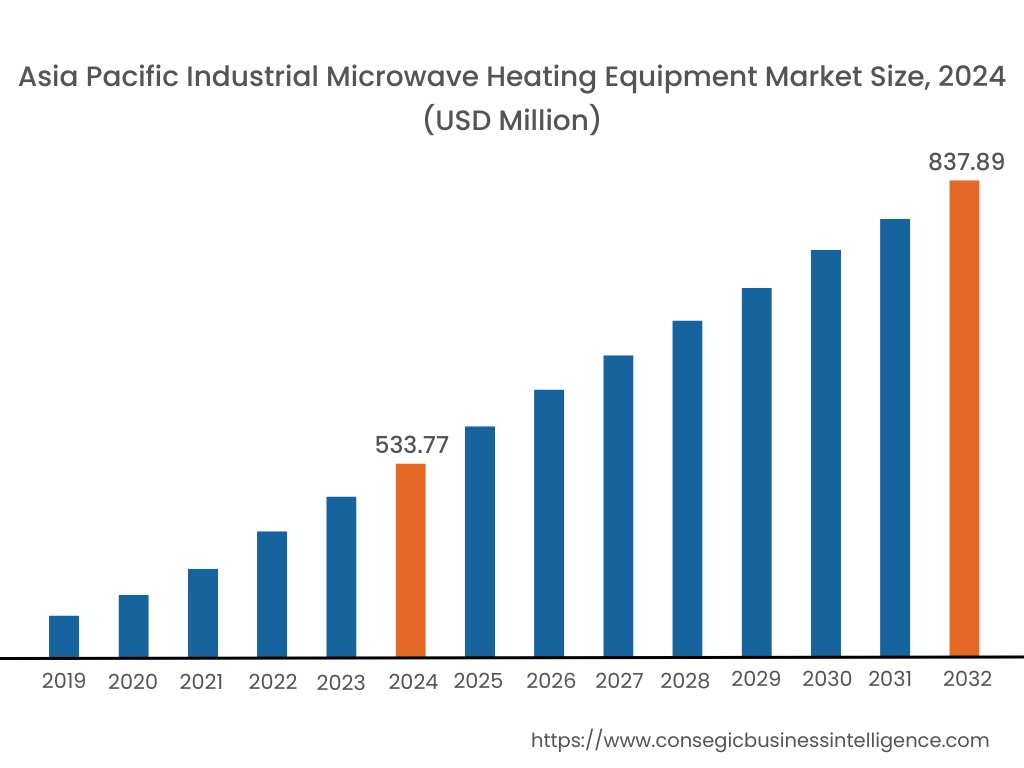
Asia Pacific region was valued at USD 533.77 Million in 2024. Moreover, it is projected to grow by USD 555.71 Million in 2025 and reach over USD 837.89 Million by 2032. Out of this, China accounted for the maximum revenue share of 38.2%. The market for industrial microwave heating equipment is mainly driven by rapid industrialization, a burgeoning food and beverage sector, increasing adoption of advanced technologies in pharmaceutical and chemical industries, rising demand for efficient and sustainable processing methods, and growing investments in research and development activities related to microwave heating technology. The region's large population and rising disposable incomes also contribute to the growth of end-user industries, further fueling the demand for industrial microwave heating equipment.
- For instance, in 2021 Richardson Electronics added Junkosha's MWX004 interconnect cables to their microwave product offerings. These cables feature 1.0mm or 0.8mm connectors with a "safety lock" to protect the center pin. They are designed for applications up to 145 GHz, exceeding current 5G frequency needs and allowing for second harmonic spur evaluation. Custom cable lengths are available with a quick 2-3 week delivery time.
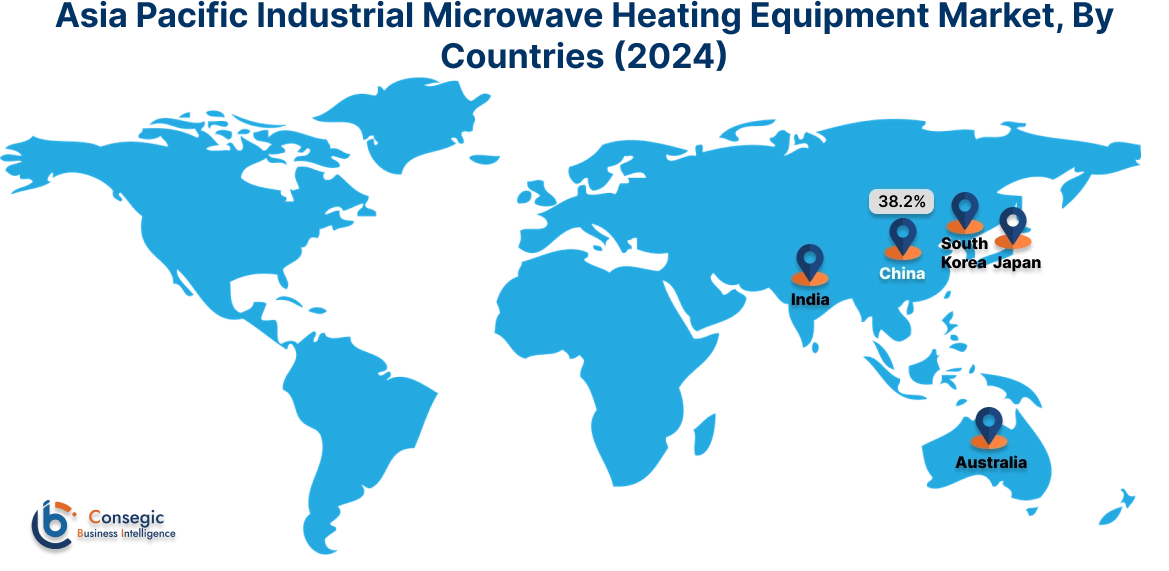
North America is estimated to reach over USD 638.66 Million by 2032 from a value of USD 391.27 Million in 2024 and is projected to grow by USD 408.69 Million in 2025. The North American market is mainly driven by a strong focus on technological advancements, a well-established food and beverage processing sector, stringent food safety regulations, increasing adoption of automation and advanced manufacturing techniques, and a growing emphasis on energy efficiency and sustainable practices.
- For instance, in March 2021, Ampegon installed and commissioned a 300kW solid-state 500MHz RF amplifier system at Brookhaven National Laboratory's NSLS-II Synchrotron. This new system replaces the previously used klystron amplifiers, providing the RF power needed to accelerate electrons to near light-speed for x-ray generation used in scientific research.
The regional trends analysis depicts that the stringent environmental regulations promoting energy efficiency, a high level of automation in manufacturing industries, and a strong focus on food safety and quality in Europe is driving the market. Additionally, the primary factor driving the market in the Middle East and African region is the expanding food and beverage sector, coupled with growing investments in infrastructure development and increasing awareness of the benefits of microwave heating technology in various industrial applications. Further, the adoption of modern food processing technologies and growing demand for convenience foods is paving the way for the progress of market in Latin America region.
Top Key Players and Market Share Insights:
The global industrial microwave heating equipment market is highly competitive with major players providing solutions to the national and international markets. Key players are adopting several strategies in research and development (R&D), product innovation, and end-user launches to hold a strong position in the industrial microwave heating equipment industry. Key players in the industrial microwave heating equipment market include-
- Ampegon (Switzerland)
- Toshiba Hokuto Electronics Corporation (Japan)
- CPI EDB (US)
- Panasonic (Japan)
- Communications & Power Industries LLC (US)
- Hitachi Power Solutions Co., Ltd. (Japan)
- Teledyne e2v Limited (UK)
- CoberMuegge LLC (US)
- L3 Electron Devices (US)
- Richardson Electronics, Ltd. (US)
Recent Industry Developments :
Mergers & Acquisitions:
- In June 2023, Microwave Techniques LLC (MT), a US-based leader in high-power microwave solutions, has acquired German RF and microwave component manufacturer Valvo Bauelemente GmbH. Both companies specialize in high-power components like circulators, isolators, and loads, serving markets like scientific and medical research. The acquisition creates synergies in customer support, product lines, and R&D, establishing MT as a leading global producer of key waveguide components (2.45 GHz, WR284, WR340, and WR430).
Industrial Microwave Heating Equipment Market Report Insights :
| Report Attributes | Report Details |
| Study Timeline | 2019-2032 |
| Market Size in 2032 | USD 2,276.87 Million |
| CAGR (2025-2032) | 6.4% |
| By Type |
|
| By Component |
|
| By Power |
|
| By End-User |
|
| By Region |
|
| Key Players |
|
| North America | U.S. Canada Mexico |
| Europe | U.K. Germany France Spain Italy Russia Benelux Rest of Europe |
| APAC | China South Korea Japan India Australia ASEAN Rest of Asia-Pacific |
| Middle East and Africa | GCC Turkey South Africa Rest of MEA |
| LATAM | Brazil Argentina Chile Rest of LATAM |
| Report Coverage |
|
Key Questions Answered in the Report
How big is the Industrial Microwave Heating Equipment market? +
The Industrial Microwave Heating Equipment Market is estimated to reach over USD 2,276.87 Million by 2032 from a value of USD 1,434.43 Million in 2024 and is projected to grow by USD 1,494.76 Million in 2025, growing at a CAGR of 6.4% from 2025 to 2032.
What specific segmentation details are covered in the Industrial Microwave Heating Equipment report? +
The Industrial Microwave Heating Equipment report includes specific segmentation details for type, component, power, end-user, and regions.
Which is the fastest segment anticipated to impact the market growth? +
In the industrial microwave heating equipment market, pharmaceutical is the fastest-growing segment during the forecast period due to increasing demand for precise and controlled heating in drug manufacturing and research, the growing adoption of microwave technology for sterilization and disinfection processes, the rising use of microwave-assisted synthesis in drug discovery and development, and stringent regulatory requirements.
Who are the major players in the Industrial Microwave Heating Equipment market? +
The key participants in the industrial microwave heating equipment market are Ampegon (Switzerland), Toshiba Hokuto Electronics Corporation (Japan), Hitachi Power Solutions Co., Ltd. (Japan), Teledyne e2v Limited (UK), CoberMuegge LLC (US), L3 Electron Devices (US), Richardson Electronics, Ltd. (US), CPI EDB (US), Panasonic (Japan), Communications & Power Industries LLC (US) and others.
What are the key trends in the industrial microwave heating equipment market? +
The industrial microwave heating equipment market is being shaped by several key trends including increasing automation and integration with production lines, growing adoption of advanced control systems for precise process management, a rising focus on energy efficiency and sustainability, and continuous advancements in microwave generation technology.
